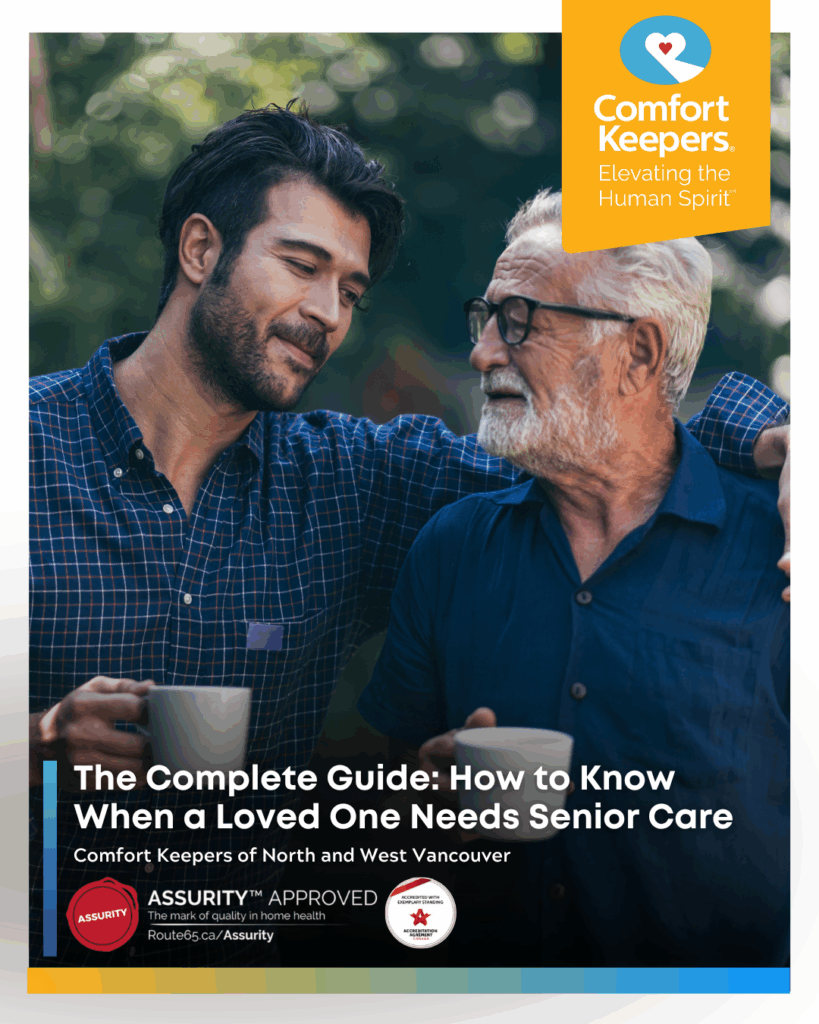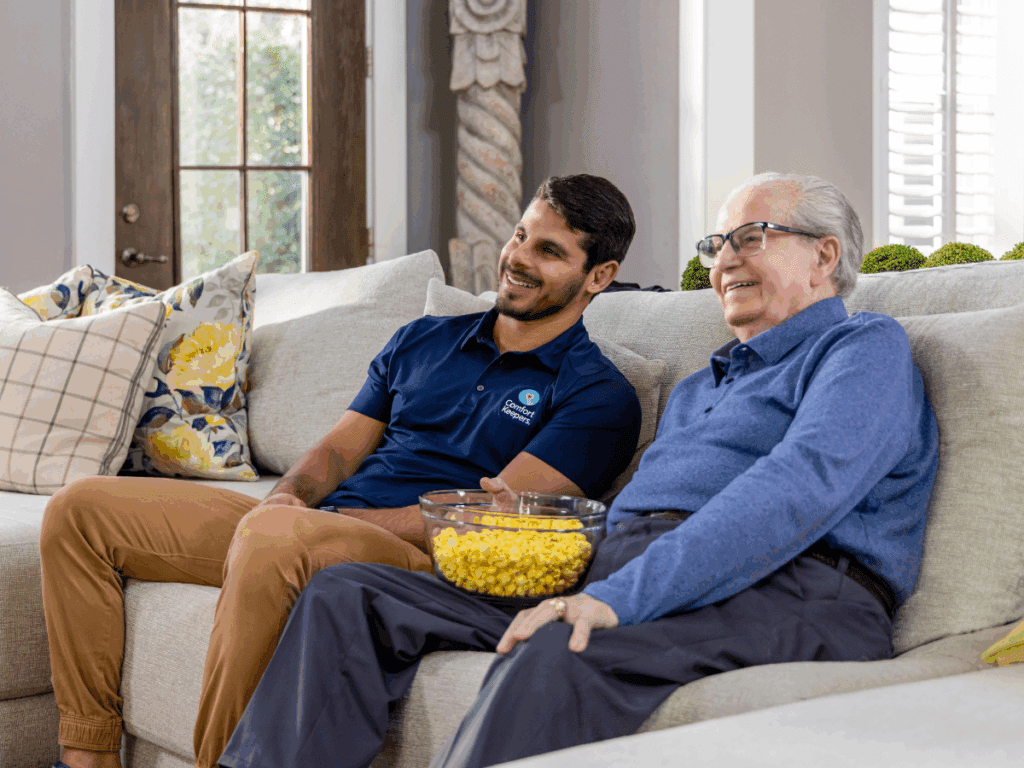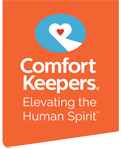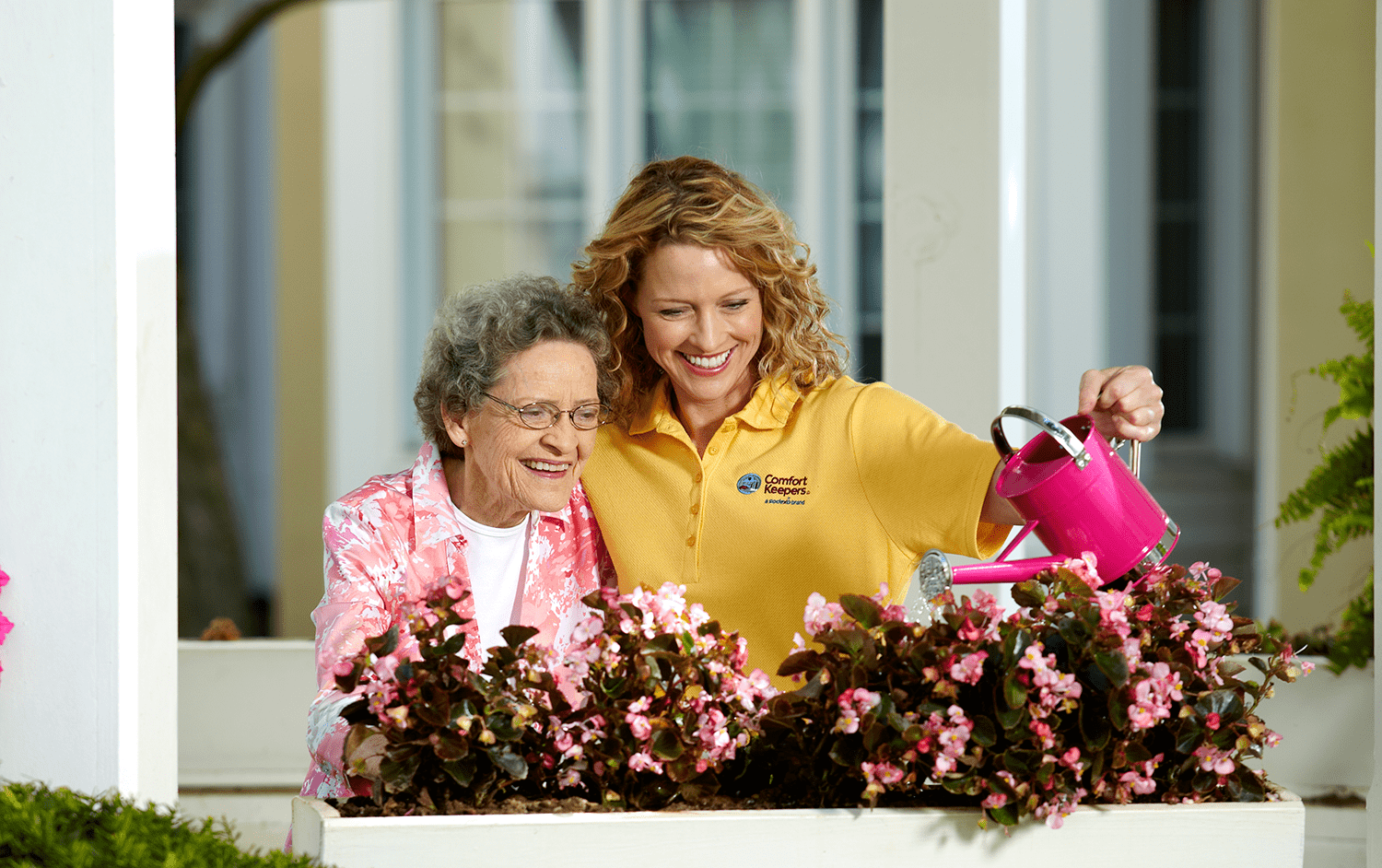The Complete Guide: How to Know When a Loved One Needs Senior Care
Senior In-Home Care | October 14, 2025
It often starts with a small, unsettling feeling. Maybe it’s a pile of unopened mail on the counter during a visit, a concerning comment about forgetting to take medication, or a fridge that’s a little too empty. You brush it off. Then it happens again. The feeling grows from a quiet whisper to a persistent worry: Is Mom okay on her own? Is Dad safe?

If you’re reading this, you’re likely navigating that confusing and emotional space. You’re caught between respecting your loved one’s independence and the growing concern that they might need more support than you can provide.
Know this: you are not alone, and your concerns are valid. This is a journey millions of families navigate. The challenge isn’t just seeing the signs; it’s knowing what they mean and what to do next. This guide is designed to give you a clear framework – moving you from anxious guesswork to confident understanding.
The First Clues: Moving Beyond a Gut Feeling
Before you can assess the need for care, you first have to learn what to look for. While every person’s situation is unique, certain patterns can indicate that daily life is becoming a challenge. Experts often group these signs into four key areas.
1. Changes in Physical Health and Appearance
These are often the most noticeable signs because they are visible.
- Unexplained Weight Loss: Could signal issues with cooking, appetite, or an underlying health problem.
- Decline in Personal Hygiene: Neglecting grooming habits like bathing, brushing teeth, or wearing clean clothes can be a sign of physical or cognitive difficulty.
- Mobility Issues: Increased trouble walking, getting up from a chair, unsteadiness, or recent falls are significant red flags.
- Sleep Pattern Changes: Either sleeping much more or much less than usual can point to health issues or depression.
2. Shifts in Cognitive Function
These changes can be more subtle but are crucial to observe.
- Memory Lapses: Especially forgetting to take medication, pay bills, or attend appointments.
- Confusion and Disorientation: Getting lost in familiar places or struggling to follow a conversation.
- Poor Judgment: Making questionable financial decisions or falling for scams.
- Loss of Interest: Abandoning hobbies and activities they once loved can be a sign of depression or cognitive decline. For those showing significant memory challenges, exploring specialized dementia and Alzheimer’s care options early is key.
3. A Changing Home Environment
The state of a person’s home is a powerful reflection of their well-being.
- A Messy or Unkempt House: Especially if they were once very tidy. Look for clutter, grime, or signs of spills not being cleaned up.
- Lack of Food: An empty fridge or pantry filled with expired food can mean they struggle with grocery shopping or cooking.
- Unpaid Bills or Late Notices: Piles of mail can hide financial disorganization, a common early sign.
- Signs of Minor Accidents: Scorch marks on pots and pans, small dents on the car, or unexplained bruises.
4. Social and Emotional Well-being
Isolation can dramatically accelerate health decline.
- Increased Isolation: Withdrawing from friends, family, or community groups.
- Changes in Mood: Noticeable shifts in personality, such as becoming more irritable, anxious, or apathetic.
If you find yourself nodding along to several points on this list, your gut feeling is pointing you toward a real need. The next step is to organize these observations into a clearer picture.
The Assessment Framework: How to Objectively Measure Care Needs
Observing signs is the first step, but how do you measure the level of need? In the world of professional care, this isn’t left to guesswork. Caregivers and healthcare providers use a structured framework built on two key concepts: Activities of Daily Living (ADLs) and Instrumental Activities of Daily Living (IADLs).
Understanding this framework is the single most powerful tool you have. It turns your vague worries into actionable data, helping you see exactly where support is needed most.
- Activities of Daily Living (ADLs): These are the fundamental skills required for self-care. Think of them as the core tasks a person must do every day to live.
- Instrumental Activities of Daily Living (IADLs): These are more complex tasks required to live independently within a community. They involve more planning and organizational skills.
Your ADL & IADL Checklist
Use this checklist to create a clear, objective snapshot of your loved one’s abilities. Go through it honestly. Does your loved one need help with any of these tasks?
Activities of Daily Living (ADLs)
- Bathing & Showering: Can safely get in and out of the tub or shower. Can wash themselves independently.
- Dressing: Can select appropriate clothes for the weather/occasion. Can put clothes on independently.
- Eating: Can physically feed themselves (including bringing food to mouth, chewing, and swallowing)
- Toileting: Can get to and from the toilet independently. Can manage personal hygiene (wiping, adjusting clothing)
- Transferring: Can move from bed to chair independently. Can move from bed to wheelchair independently (if applicable)
Struggles with ADLs often indicate a need for hands-on support. Services that focus on personal care are specifically designed to assist with these essential tasks, preserving dignity and safety.
Instrumental Activities of Daily Living (IADLs)
- Managing Finances: Can they pay bills on time and manage a budget?
- Meal Preparation: Can they plan and cook healthy meals? A program like our home care services can be crucial for those struggling to make consistent and healthy meals.
- Shopping: Are they able to get to the store and purchase groceries or other necessities?
- Housekeeping: Can they keep their living space reasonably clean and safe?
- Transportation: Can they drive safely or arrange for other transport?
- Managing Medications: Can they take the correct doses at the right times?
- Communication: Can they use a phone or other devices to contact others?
Difficulties with IADLs are often the first signs that full independence is becoming a strain. This is where many families find that introducing professional in-home care services can make a world of difference, allowing a senior to remain at home while getting support for these specific tasks.
From Observation to Action: A Step-by-Step Guide
You’ve observed the signs and used the ADL/IADL framework to get a clearer picture. Now what? The path forward can feel daunting, but it can be broken down into manageable steps.
This process transforms an emotional burden into a structured plan. You are no longer just worrying; you are gathering information and preparing to find a supportive solution.

A Compassionate Guide to “The Talk”
This is often the hardest step. Many seniors fear that accepting help means losing their independence. The key is to frame the conversation around preserving their independence, not taking it away.
Tips for a Successful Conversation:
- Choose the Right Time and Place: Find a calm, comfortable setting where you won’t be rushed. Don’t start the conversation when you’re feeling stressed or tired.
- Use “I” Statements: Instead of “You’re not eating right,” try “I’m worried that you might not be getting the nutrition you need. How can we make it easier?”
- Listen More Than You Talk: Ask open-ended questions like, “What are the hardest parts of your day?” or “What are some things you wish you had a little help with?” Their answers will reveal where they feel the most strain.
- Focus on Benefits, Not Deficits: Emphasize what they will gain. “Having someone help with laundry and errands would give you more energy for your gardening.” Or “A little help around the house could help prevent a fall, so you can keep living here safely for years to come.”
- Offer Options, Not Ultimatums: Present it as a collaboration. Instead of saying, “You need a caregiver,” ask, “What if we looked into someone who could come by a few times a week to help with meals and driving? We could try it out and see how it feels.”
Common Questions Families Ask About Senior Care
It’s normal to have a lot of questions. Here are answers to some of the most common concerns.
How do I cope with the guilt of admitting I can’t do it all?
This is perhaps the most common feeling among family caregivers. It’s crucial to reframe this thought. Recognizing you need help is not a sign of failure; it’s a sign of love. Bringing in professional support prevents caregiver burnout and allows you to focus on your relationship with your parent, rather than just being their caregiver.
What if my parent refuses care?
Resistance is normal. It stems from fear of change and loss of control. If they refuse, don’t push. Let the idea sit for a while and bring it up again later. Sometimes, involving a trusted third party, like their doctor or a family friend, can help. Framing it as a trial run – “Let’s just try it for two weeks” – can also make it less intimidating.
What’s the difference between companionship and personal care?
Companionship care focuses on IADLs and social well-being—things like meal prep, light housekeeping, running errands, and simply providing social interaction. Personal care addresses the ADLs—the hands-on tasks like bathing, dressing, and mobility assistance. Many people start with companionship care and add personal care as needs increase.
Does professional care mean my parent loses their independence?
Absolutely not. In fact, the opposite is true. The goal of quality in-home care is to sustain and enhance independence. By providing support for challenging tasks, professional caregivers help seniors live safely and comfortably in their own homes for as long as possible. It’s about adding support, not taking away freedom.
Your Path to Clarity and Peace of Mind
Recognizing that a loved one needs help is a pivotal moment. It’s filled with emotion, but it’s also an opportunity to ensure their safety, happiness, and dignity. By moving from simple observation to a structured assessment, you can replace fear with a clear, actionable plan. You are taking the first and most important step toward providing the best possible support for the person you love.
The journey of caregiving is a marathon, not a sprint. Arming yourself with knowledge is the best way to navigate the road ahead. When you’re ready to understand how these concepts apply to your unique situation, the next step is often a simple conversation.
A free in-home consultation can provide a professional, no-obligation assessment, giving your family a personalized roadmap for what support could look like. It’s a simple, confidential way to get expert answers and find peace of mind.
The Best Senior Home Care in North and West Vancouver is Comfort Keepers®
Our senior home care agency offers in-home care focusing on aging in place. Our services include dementia care, end-of-life care, post-surgery care, and palliative care. Comfort Keepers can assist seniors with living transition services, personal care, companionship care, and more!
Quality and Accredited Elderly Care: Happier, Healthier, and at Home with 24/7 Senior Care Opportunities!
Do you need a home care solution for yourself or a loved one? Have you been thinking about retirement homes and their alternatives as a solution? Comfort Keepers® enables seniors to maintain happy, healthy lives in the comfort of their own homes. In-home care services are available in North Vancouver, West Vancouver, and the surrounding areas.
Comfort Keepers® is a Senior Care Agency That Can Make a Difference with Interactive Caregiving™
Our in-home caregivers ensure our senior clients have the best quality of life. The Interactive Caregiving™ program ensures that a senior’s safety, nutrition, mental well-being, and everyday needs are met. This program brings joy and good health to each client’s home.
Comfort Keepers® North Vancouver and West Vancouver Can Help with In-Home Elderly Care Services!
If you are concerned about the health and well-being of a loved one we can help! Comfort Keepers offers 24-hour care and delivers top-quality and compassionate care for seniors. We are dedicated to safety technology solutions that foster independence and enhance well-being.
Locally Owned and Operated Home Health Care Agency
Our care centers around companionship for seniors. Empathetic care originates from the soul and allows us to meet our client’s requirements. The seasoned in-home caregivers employed by Comfort Keepers are carefully chosen based on their empathetic qualities.
Contact the Comfort Keepers® North Vancouver and West Vancouver office at (604) 998-8806 to learn more about our unique in-home care solutions for seniors.
Comfort Keepers is an Accredited Senior Care Agency in North and West Vancouver, BC
Accreditation is a rigorous process that involves industry experts evaluating an organization’s processes, policies, and procedures. Comfort Keepers® North and West Vancouver has been awarded Exemplary Standing by Accreditation Canada. This achievement recognizes that Comfort Keepers® meets or exceeds the stringent quality standards for Home Care companies established by Accreditation Canada.
Individualized Home Care Options
Long-Term Home Care, 24 Hour Home Care & Short Term Care Options Customized for You





